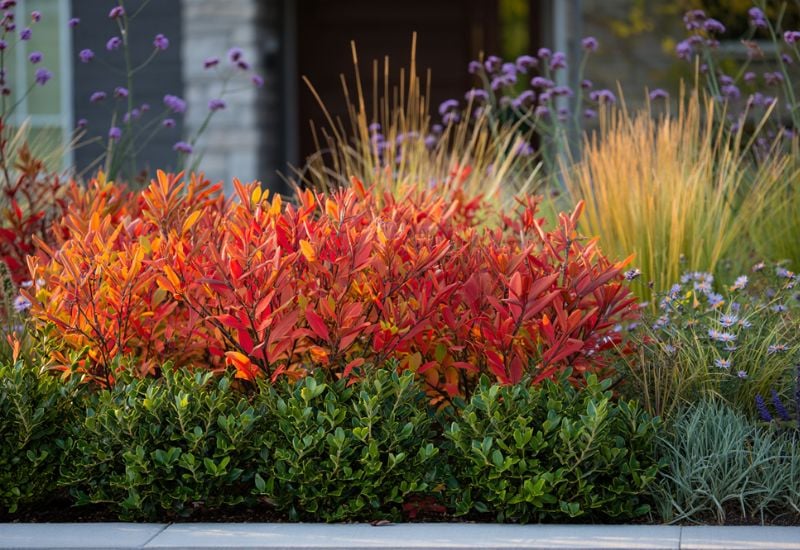
Ever walk past your boxwood hedge and think, “Why does this look worse every year?” You’re not imagining it. Across the U.S., boxwood—once the gold standard for tidy, year-round green—is quietly falling apart. Boxwood blight has now spread through more than 30 states, wiping out whole hedges and leaving bare sticks where lush borders used to be (North Carolina field study). In some areas, up to 95% of plants are gone, and the losses for homeowners and growers run into the millions (USDA research; industry report).
Even the survivors aren’t winning any awards. Boxwoods demand constant trimming, fertilizing, and spraying just to stay alive. And what do they give back? Pretty much nothing. Landscape studies show that gardens planted with boxwood host up to 90% fewer pollinators than those filled with native shrubs (ecological analysis). No nectar, no berries, no bird food—just silent, sterile greenery.
It’s a strange trade-off, isn’t it? We baby these shrubs through pests and diseases, spend on chemicals to keep them green, and end up with something that doesn’t even help the living world around it.
But there’s a better way. Native shrubs offer the same polished structure and evergreen presence—without the blight, without the chemicals, and with a lot more life. Research shows that switching from boxwood to native plants can triple pollinator visits, reduce pesticide use, and restore balance to the landscape (pollinator study).
So if your hedge is starting to look tired, or you’re simply tired of fighting nature, maybe it’s time to let the natives take over. Here are 11 stunning shrubs that outshine—and outlast—boxwood, giving you the same shape and structure with a garden that actually buzzes back.
1. Inkberry Holly (Ilex glabra)
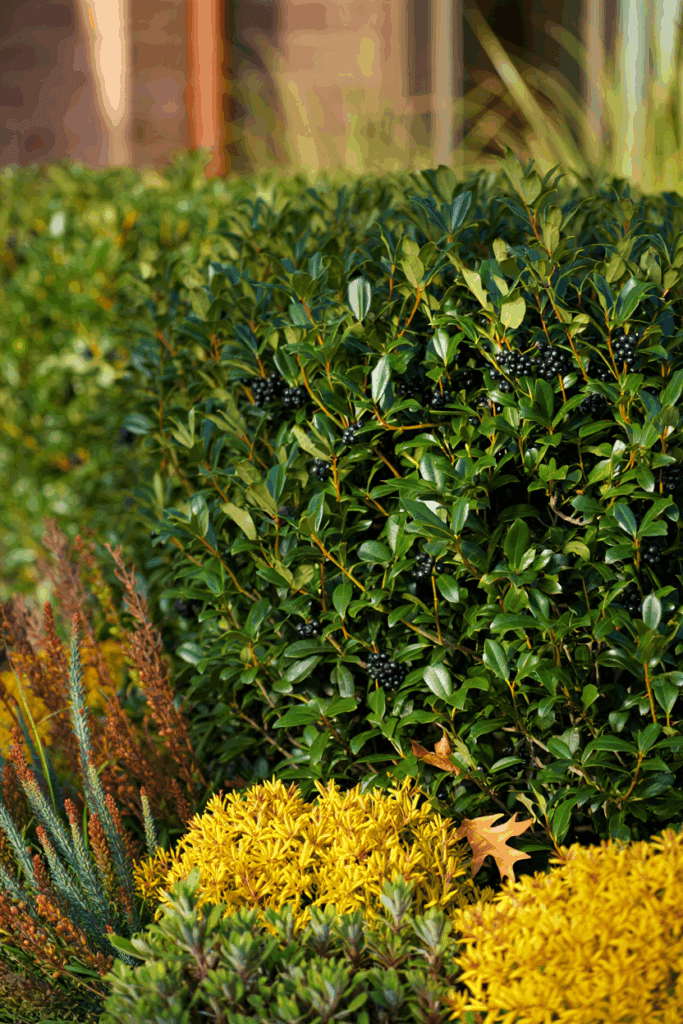
Zones 5–9 | Evergreen | Sun to Part Shade
If you’ve ever wished your boxwoods stayed healthy through wet winters or didn’t attract blight, Inkberry holly is your answer. Native to the eastern U.S., this broadleaf evergreen forms neat, dense mounds of glossy green foliage — almost identical in texture to boxwood, but with a natural resilience that makes it far tougher in the long run.
Unlike boxwood, inkberry actually likes moisture. It thrives in the kind of slightly damp, acidic soils where boxwood would sulk, yet it also tolerates average garden conditions once established. Its smooth, spineless leaves give it a soft, refined look that plays well in both traditional and naturalistic gardens.
For a low hedge, look for compact cultivars like ‘Shamrock’ or ‘Gem Box®’, which naturally hold a tidy, rounded form without constant shearing. Left to its own devices, inkberry forms a lush evergreen mass about 3–6 ft tall — perfect for foundation plantings, rain gardens, or as a soft-edged substitute in mixed borders.
And here’s the real bonus: this native holly supports pollinators and produces small black berries that feed winter birds — a gift boxwood can’t offer. If you’re pairing shrubs, give it the company of other moisture-loving natives like Clethra alnifolia or Itea virginica for a layered, ecologically rich foundation.
2. Dwarf Yaupon Holly (Ilex vomitoria ‘Nana’)

Zones 7–10 | Evergreen | Sun to Part Shade
If you garden anywhere in the South, this is the boxwood alternative you’ve been waiting for. Dwarf yaupon holly has the same tidy, small-leaved look but shrugs off the heat, humidity, and drought that make boxwoods struggle. It’s also unbothered by the fungal blight that’s wiped out so many hedges across the region — a major relief for anyone tired of replacing dead plants.
The compact ‘Nana’ form naturally grows into a dense, rounded mound about 3–4 ft tall, maintaining its shape with almost no pruning. The tiny, glossy leaves give it that “clipped” look even when you never touch the shears. Unlike its larger yaupon cousins, this one stays polite and manageable, perfect for foundation plantings, formal borders, or low evergreen edging.
It’s tough, too — tolerant of salt spray, wind, poor soil, and reflected heat from pavement. Deer pass it by, while birds flock to its red berries in fall and winter. And because it’s native to the Southeast, it’s adapted to local pests and climate swings in a way boxwood never will be.
For a more natural look, try massing several plants and letting them grow into soft, mounded drifts. They’ll stay lush and green all year, offering structure through every season — no chemicals, no shearing, no stress.
3. Globe Arborvitae (Thuja occidentalis)

Zones 3–7 | Evergreen | Full Sun to Light Shade
If you’re tired of babying boxwoods through cold snaps or worrying about blight, globe arborvitae gives you the same evergreen structure — without the drama. Native to the northern U.S. and Canada, this small, naturally rounded form of arborvitae keeps its shape beautifully on its own. No clipping, no winter burn, no fungal heartbreak.
Its fine, feathery foliage has a softness that feels lush year-round, turning a gentle golden-green in winter. Cultivars like ‘Danica,’ ‘Tater Tot®,’ and ‘Mr. Bowling Ball’ stay under 3 ft tall and wide, making them ideal for foundation plantings, front-yard borders, or as a tidy frame for perennial beds. If you need something a bit taller, ‘Woodwardii’ grows into a perfect low hedge at around 4–5 ft.
Unlike boxwood, globe arborvitae doesn’t sulk in heavy soils or cold winds — in fact, it thrives on them. It’s happiest in full sun with evenly moist, well-drained soil, but it’s more forgiving of northern clay and spring wetness than most evergreens. Just keep it out of constant shade or hot, dry reflected heat.
And here’s a bonus: it’s a true native, supporting wildlife and providing shelter for small birds through winter. With no pruning needed and excellent cold tolerance, it gives you that sculpted, evergreen backbone every garden needs — without the fuss or the risk.
4. American Yew (Taxus canadensis)
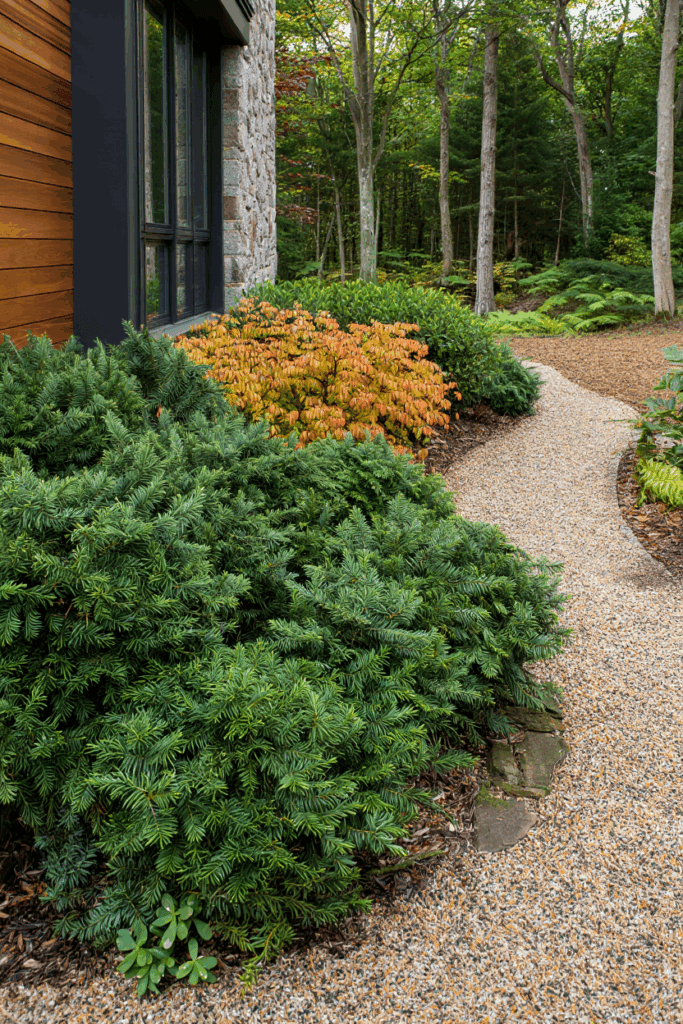
Zones 4–7 | Evergreen | Part Shade to Shade
If boxwood has always felt too fussy for your shady or northern garden, meet American yew — the native evergreen that quietly outperforms it where boxwood struggles. Found naturally in the cool woodlands of the Northeast and upper Midwest, this hardy yew brings the same dense, deep-green look but with far greater tolerance for cold, snow, and low light.
It grows as a graceful, spreading shrub — usually 3–5 ft tall and 6–8 ft wide — with soft, flat needles that stay rich green all winter. Instead of forming stiff, upright mounds, Taxus canadensis drapes gently over slopes, stone walls, or woodland edges, giving structure without formality. It’s slow-growing but very long-lived, and if you prefer a more compact hedge, it takes light pruning beautifully.
Unlike boxwood, which resents shade and wet feet, American yew thrives in cool, moist, well-drained soil and filtered light. It’s one of the few evergreen shrubs that can create a lush, layered effect under tall trees — perfect for pairing with ferns, trillium, or native hydrangeas like Hydrangea arborescens.
Just one important note: all yews, including this native species, are toxic if ingested by pets or livestock, so site it thoughtfully. Otherwise, it’s a remarkably low-maintenance, shade-tolerant evergreen that offers the year-round depth and texture of boxwood — only tougher, wilder, and far more at home in a natural landscape.
5. Carolina Cherry Laurel (Prunus caroliniana)
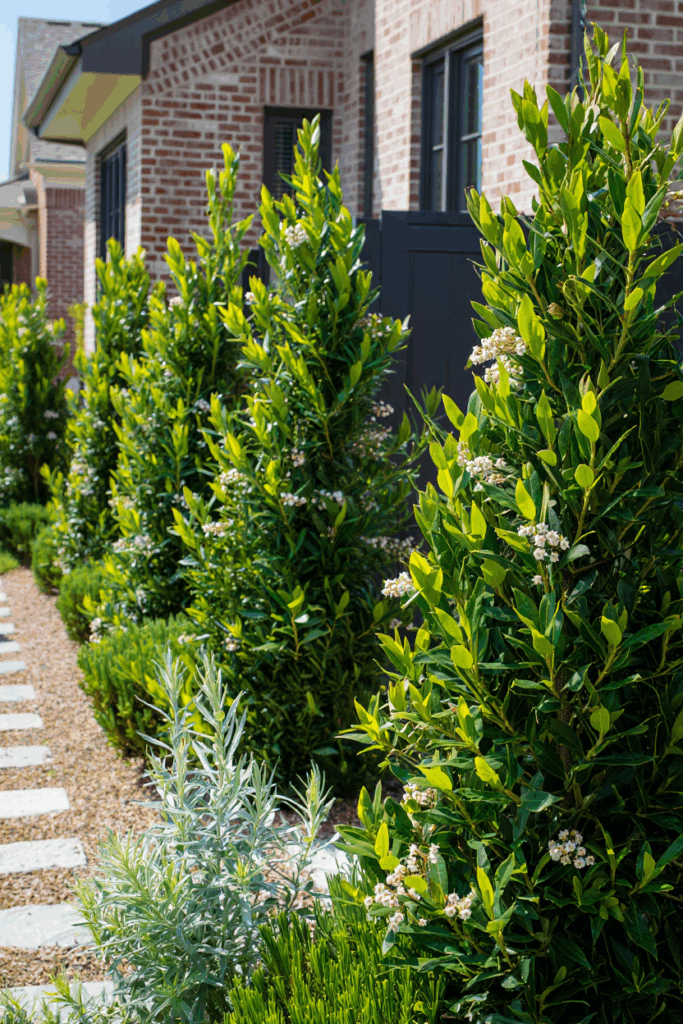
Zones 7–10 | Evergreen | Full Sun to Part Shade
If you garden in the South and wish your boxwoods could survive the heat, humidity, and blight, Carolina cherry laurel is your low-maintenance upgrade. Native to the Southeast, it has the same dense, glossy look but with far more toughness — thriving where boxwoods melt down.
The small, shiny leaves are deep green and tightly spaced along the stems, giving the shrub a naturally polished look even without clipping. In early spring, fragrant white flower clusters appear, buzzing with native bees and followed by small black fruits that feed songbirds. It’s one of those rare evergreens that look formal but still function ecologically.
Compact varieties like ‘Bright ’n Tight’ or ‘Compacta’ are garden workhorses — staying around 6–8 ft tall and forming thick, privacy-grade screens that need pruning only once or twice a year. Left to grow, the species can reach 15–20 ft and even serve as a small evergreen tree, perfect for framing driveways or softening building corners.
Once established, Carolina cherry laurel handles drought, wind, salt spray, and poor soil with ease — things that would send most boxwoods into decline. It prefers full sun but tolerates partial shade, and it’s happiest in well-drained soil with occasional deep watering during long dry spells.
Think of it as the Southern answer to boxwood: glossy, evergreen, and naturally elegant — but built to handle real-world conditions instead of pampered ones.
6. Evergreen Huckleberry (Vaccinium ovatum)

Zones 7–9 | Evergreen | Part Shade to Shade
For gardeners who want the year-round polish of boxwood without the monotony, evergreen huckleberry offers a richer, more dynamic alternative. This Pacific Coast native has small, lustrous leaves that emerge copper-bronze and deepen to a cool, glossy green — a natural gradient that gives it depth and texture boxwood never achieves.
In spring, dainty clusters of pinkish-white urn-shaped flowers appear, quietly buzzing with native bees. By late summer, they ripen into glossy black berries that birds flock to (and you can nibble on too). The overall effect is refined yet wild — neat enough for a foundation planting, but with the spirit of a woodland edge.
It grows slowly and densely, forming a rounded shrub about 3–6 ft tall, thriving in acidic, well-drained soil and dappled light. Once established, it tolerates drought, sea air, and even a bit of pruning if you want to shape it. Deer generally leave it alone.
If boxwood feels static or sterile, this shrub brings the same evergreen reliability but with movement, bloom, and life — a living hedge that actually belongs to your ecosystem.
7. Coastal Doghobble (Leucothoe axillaris)

Zones 5–9 | Evergreen | Shade to Part Shade
If boxwoods feel too static for your shady spaces, coastal doghobble brings that same evergreen reliability — but with natural rhythm and grace. Native to the woodland understories of the southeastern U.S., it grows in elegant, arching layers of glossy leaves that shift from deep green in summer to rich bronze-red through winter. It’s one of those rare evergreens that looks sculptural even when it’s not trying.
In spring, slender racemes of white, bell-shaped flowers dangle beneath the stems, feeding native bees and adding a quiet shimmer to shaded borders. The shrub typically reaches 3–4 ft tall and wide, spreading gently by underground stems to form lush colonies that work beautifully under taller shrubs, along foundations, or beside shaded paths.
Coastal doghobble prefers acidic, humus-rich soil with steady moisture — similar to azaleas and mountain laurels — but once settled, it’s surprisingly tough and deer-resistant. It thrives where boxwood fails: deep shade, damp clay, and filtered woodland light.
The effect is refined yet natural — an evergreen that bridges the formal and the wild, offering texture, color, and movement all year long.
8. Dwarf Sweetspire (Itea virginica ‘Little Henry’)
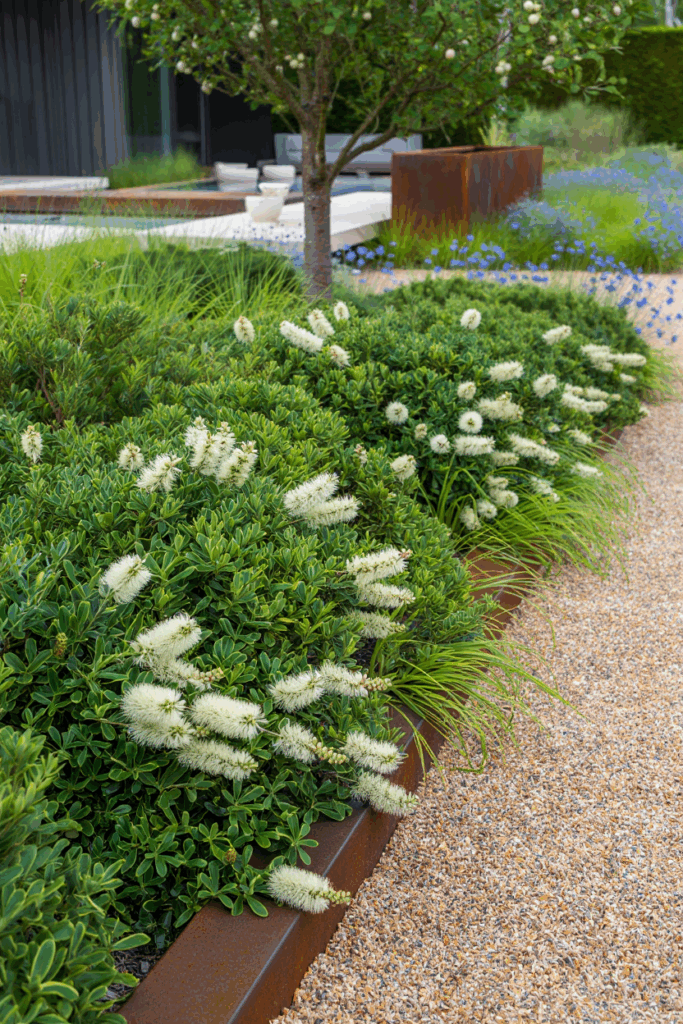
Zones 5–9 | Semi-evergreen in mild zones | Sun to part shade
If boxwood’s classic shape had a fragrant, flowering cousin, it would be Dwarf Sweetspire, ‘Little Henry’. This native shrub naturally mounds into a neat, compact form shaping up beautifully without fuss. In early summer, it announces itself with elegant spikes of creamy white, lightly scented flowers that attract an army of pollinators—think butterflies, bees, and hummingbirds—bringing your garden to life.
What makes ‘Little Henry’ stand out as a boxwood replacement? It’s the showstopping fall color. When many shrubs hit the snooze button, this native turns blazing scarlet and orange, painting your landscape with warm, vivid hues that lure admiring glances all season long.
Worried about winter? In milder parts of its zone range, it hangs onto most of its leaves, giving your garden some semi-evergreen texture, while further north it drops them like a pro. This adaptability means you get a beautiful shrub that thrives from cold New England gardens to warmer southern landscapes.
‘Little Henry’ is genuinely low-maintenance and versatile. It tolerates full sun to part shade, loving moist, well-drained soil but also shrugging off occasional dry spells once established. It’s perfect for borders, woodland gardens, or mass plantings on gentle slopes where it can spread quietly to create a lush colony. Just a heads up: it can quietly spread by suckers, so keep an eye out if you want to keep it contained.
9. Dwarf Fothergilla (Fothergilla gardenii)
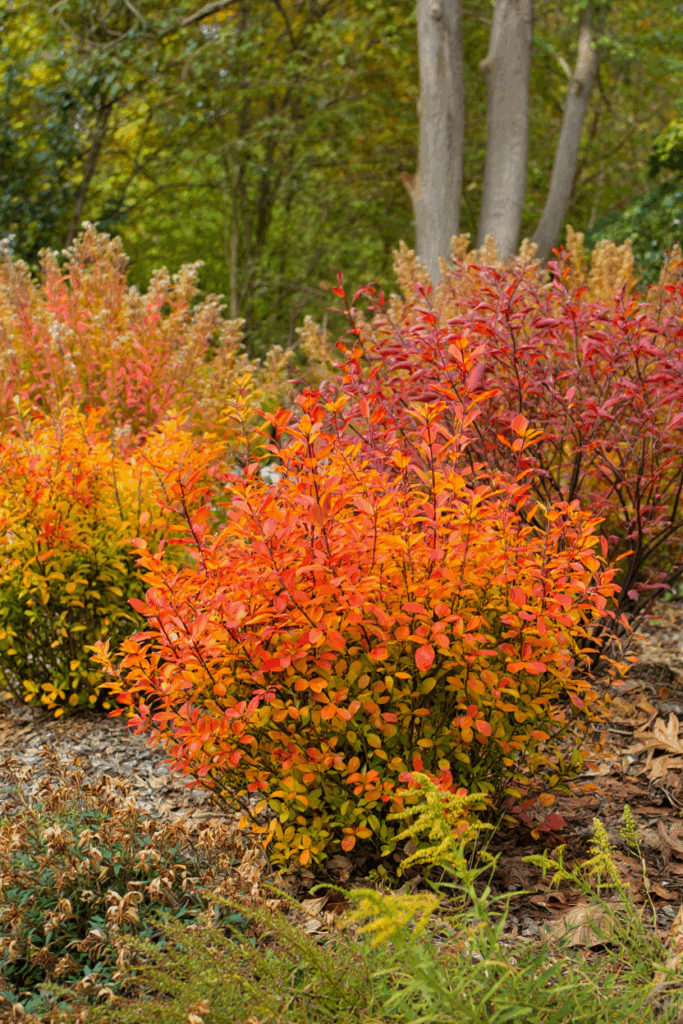
Zones 5–8 | Deciduous | Sun to Part Shade
If you can live without evergreen leaves, dwarf fothergilla rewards you with a show that boxwood could never match. Native to the southeastern U.S., this small, rounded shrub has a naturally compact form that keeps borders tidy without pruning — but it’s the seasonal color that steals the show.
In early spring, before the leaves even appear, the branches burst with clusters of creamy white, bottlebrush-like flowers that hum with native bees. The blooms are lightly fragrant, giving off a subtle honey scent that carries on cool mornings. By summer, the foliage fills in with a rich blue-green tone that stays fresh even in heat and humidity.
Then autumn arrives — and fothergilla becomes electric. The leaves turn brilliant shades of orange, red, and gold, often all on the same plant, glowing like embers in low light. It’s one of the most stunning fall displays of any native shrub.
Compact varieties like ‘Mount Airy’ or true F. gardenii stay in the 2–3 ft range, making them perfect for foundations, mixed borders, or front-of-house plantings. They thrive in acidic, well-drained soil and appreciate a bit of afternoon shade in hotter climates.
10. Creeping Wintergreen (Gaultheria procumbens)
Zones 3–8 | Evergreen Groundcover | Shade to Part Shade
If your boxwoods keep yellowing at the base or feel bulky and woody, creeping wintergreen offers a refreshing fix — literally. This native groundcover forms low, polished mounds of glossy green leaves that stay evergreen through winter, often blushing red in cold weather. It gives you that same tidy, finished look at ground level without turning into a woody blob over time.
In summer, small white, bell-shaped flowers nestle beneath the leaves, followed by bright red berries that glow through snow and last into spring. Brush against it, and you’ll catch a clean, minty scent — one of the most pleasant surprises in any shady border.
Growing just 4–6 inches tall, wintergreen spreads slowly to form neat carpets under taller shrubs or along foundations, creating a living mulch that looks manicured year-round. It thrives in acidic, humus-rich soil with steady moisture and partial shade — exactly where boxwoods tend to struggle.
For gardeners tired of woody bases and constant pruning, creeping wintergreen brings evergreen texture, fragrance, and charm in a softer, more natural form.

Written By
Amber Noyes
Amber Noyes was born and raised in a suburban California town, San Mateo. She holds a master’s degree in horticulture from the University of California as well as a BS in Biology from the University of San Francisco. With experience working on an organic farm, water conservation research, farmers’ markets, and plant nursery, she understands what makes plants thrive and how we can better understand the connection between microclimate and plant health. When she’s not on the land, Amber loves informing people of new ideas/things related to gardening, especially organic gardening, houseplants, and growing plants in a small space.
